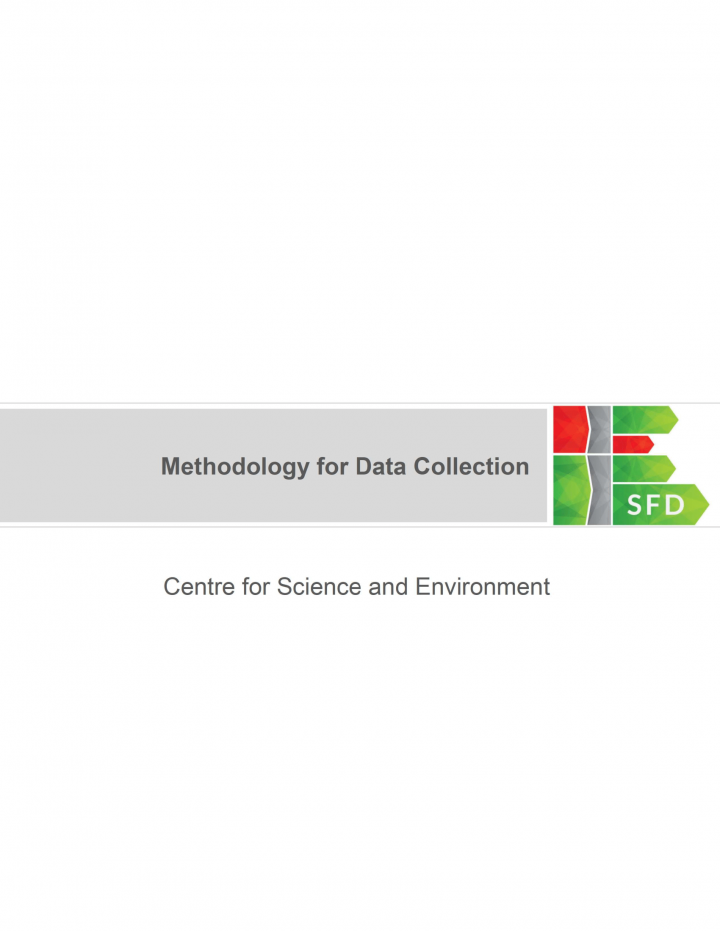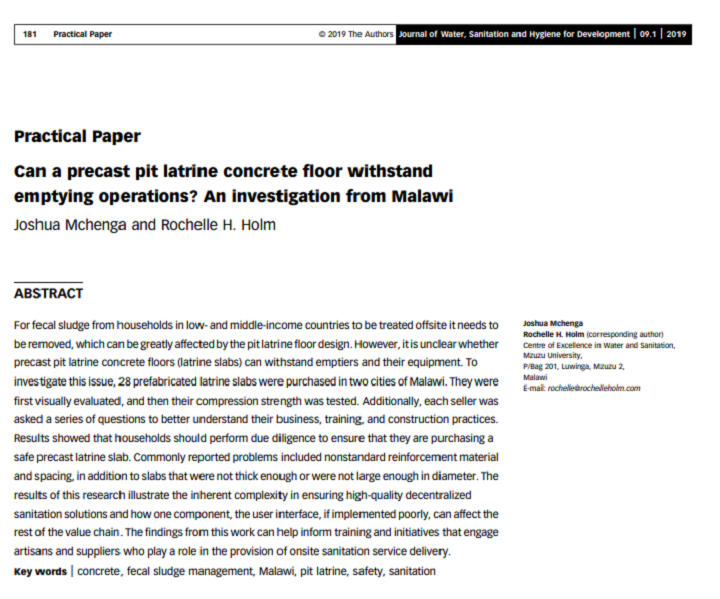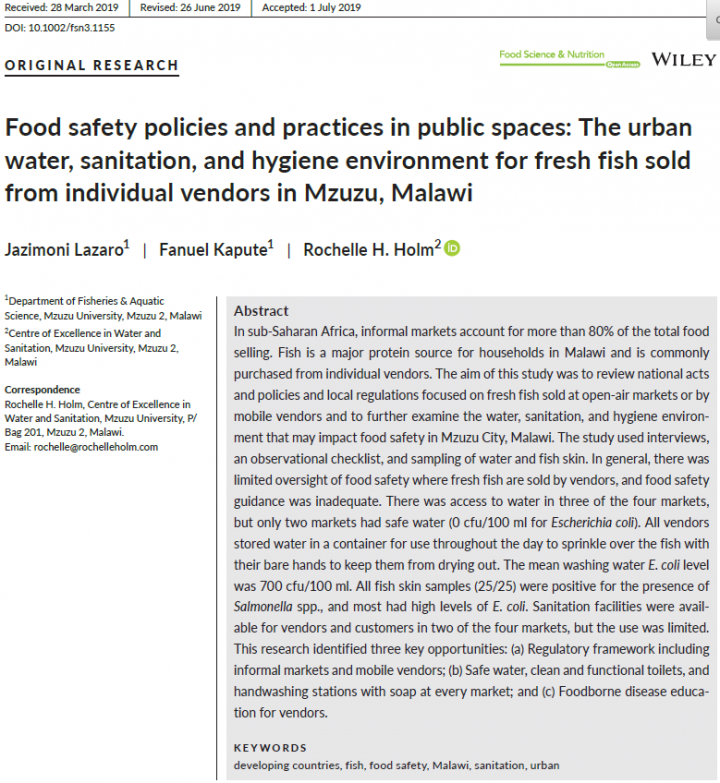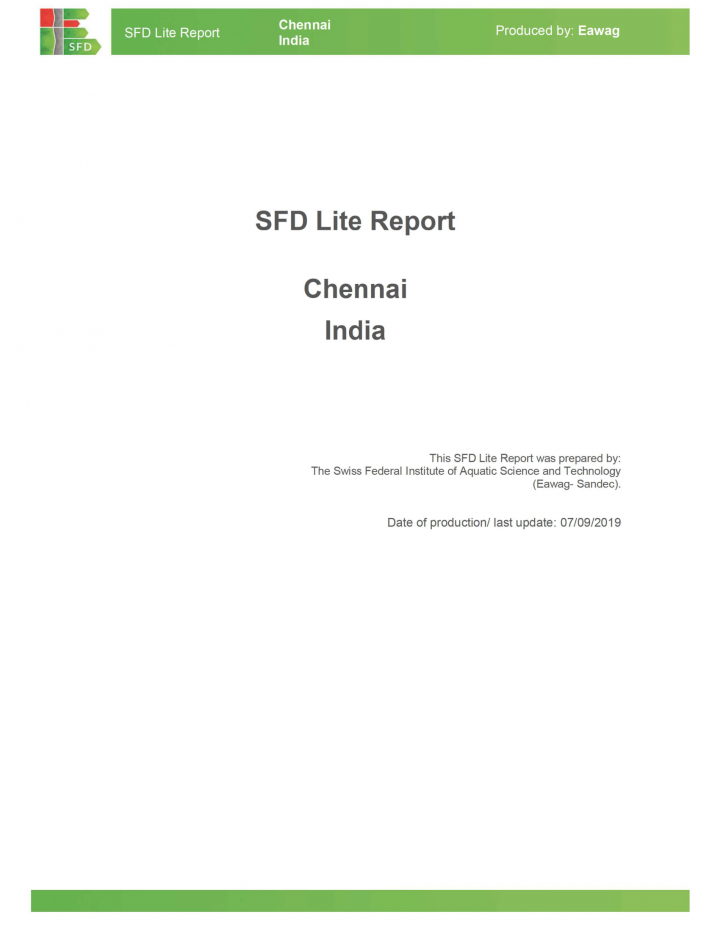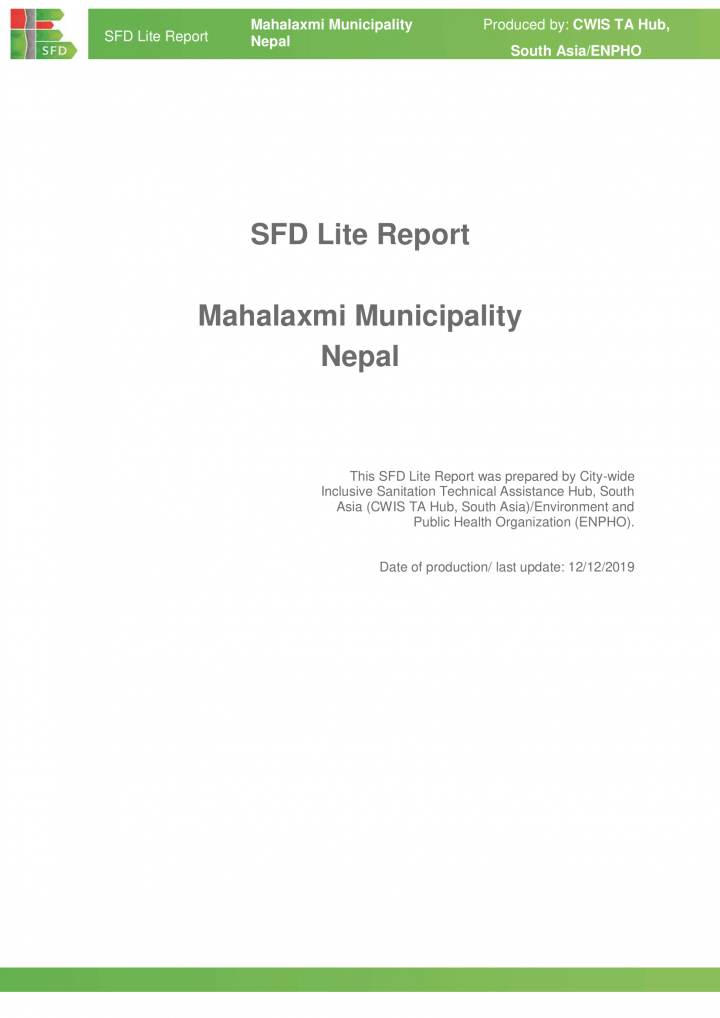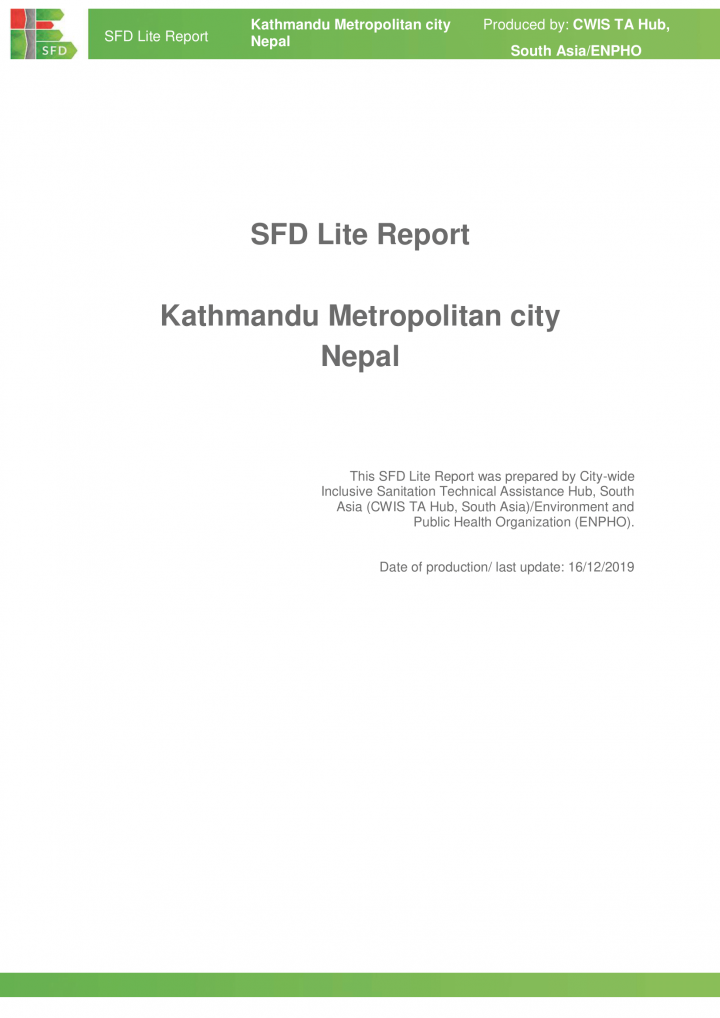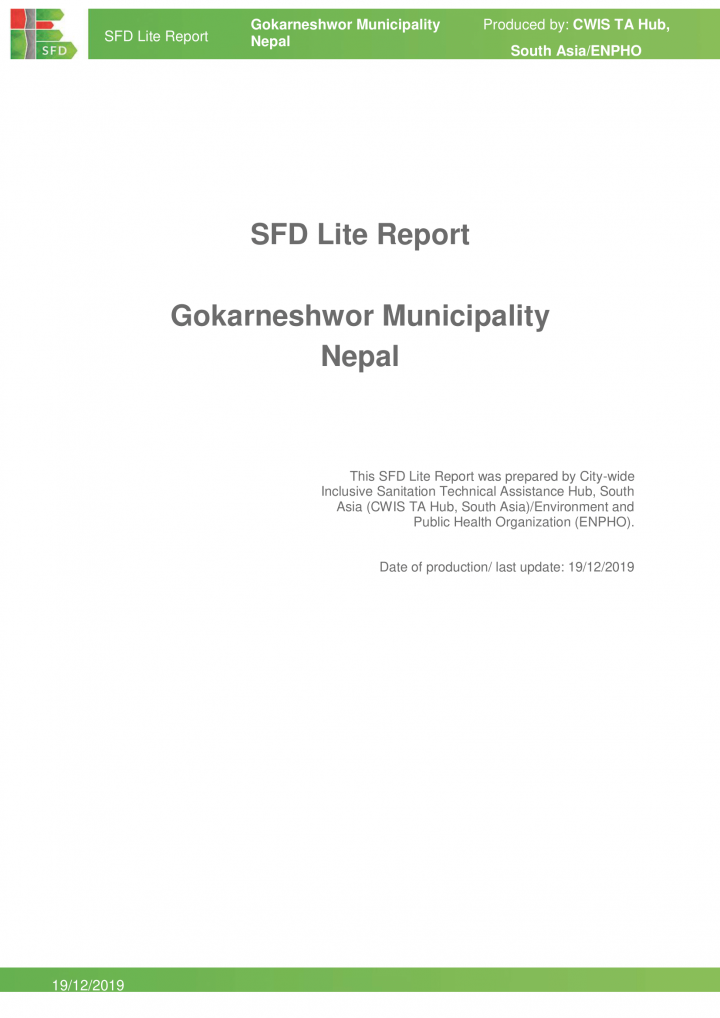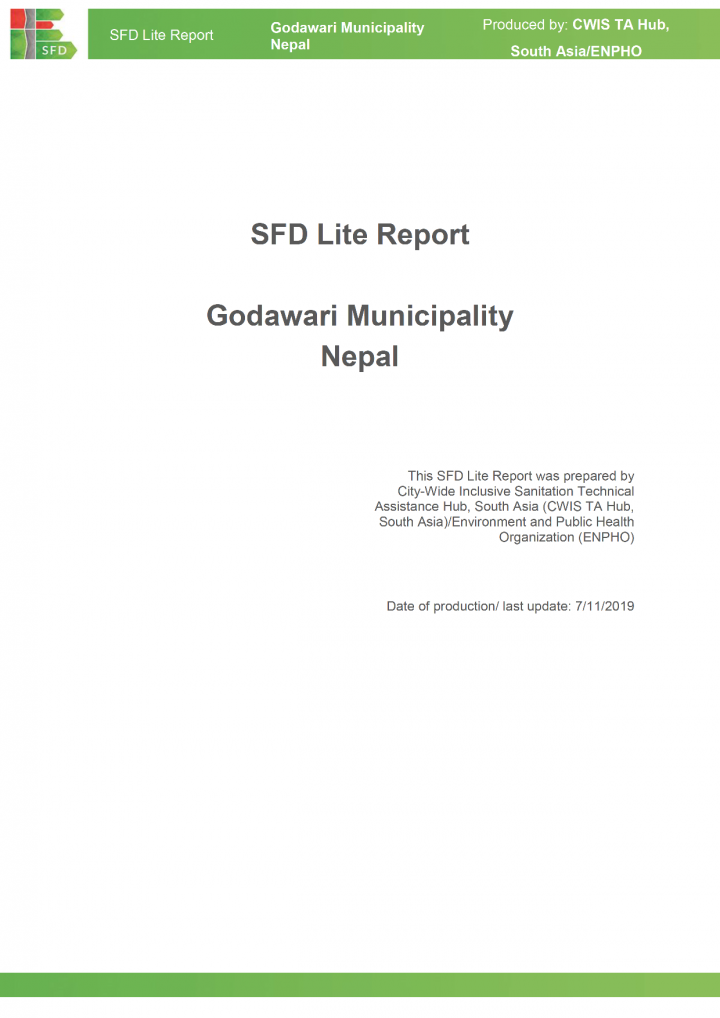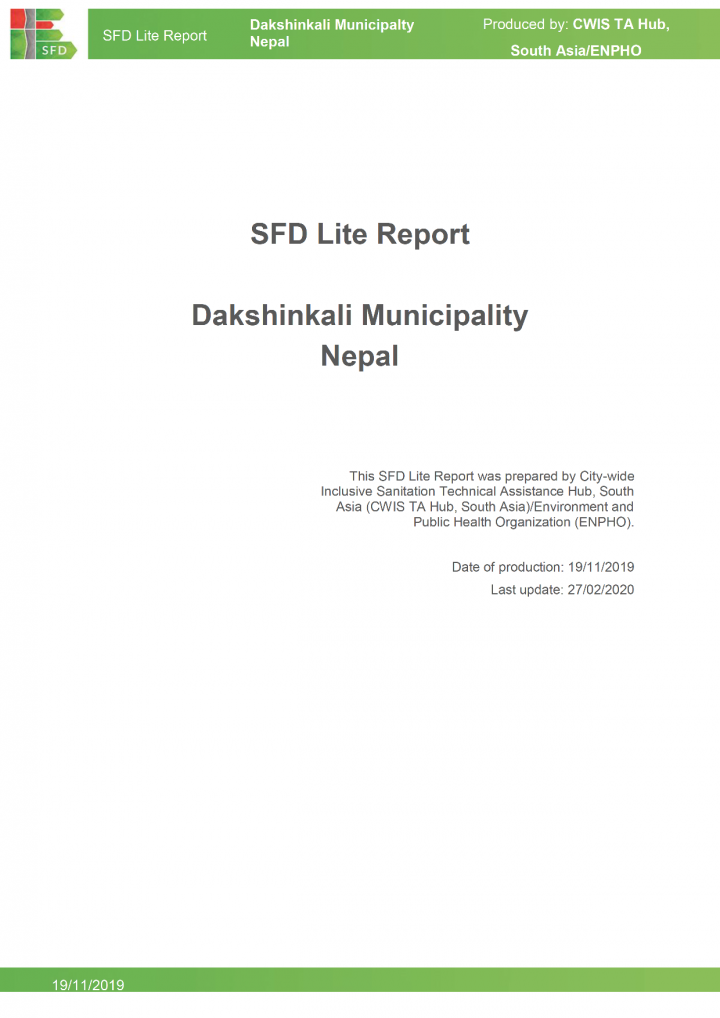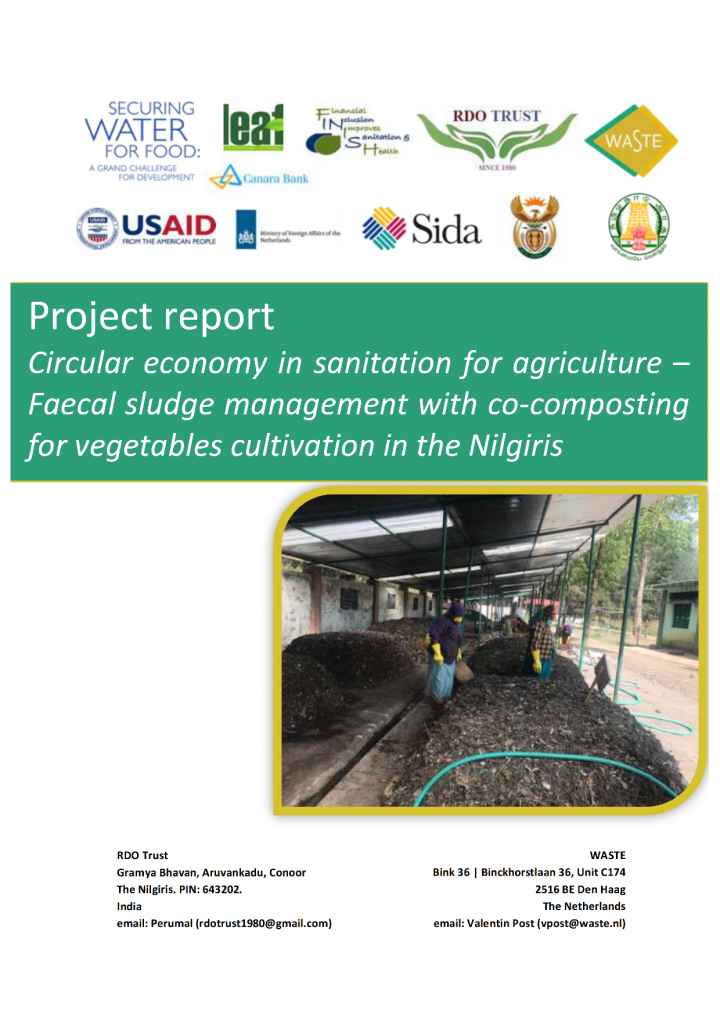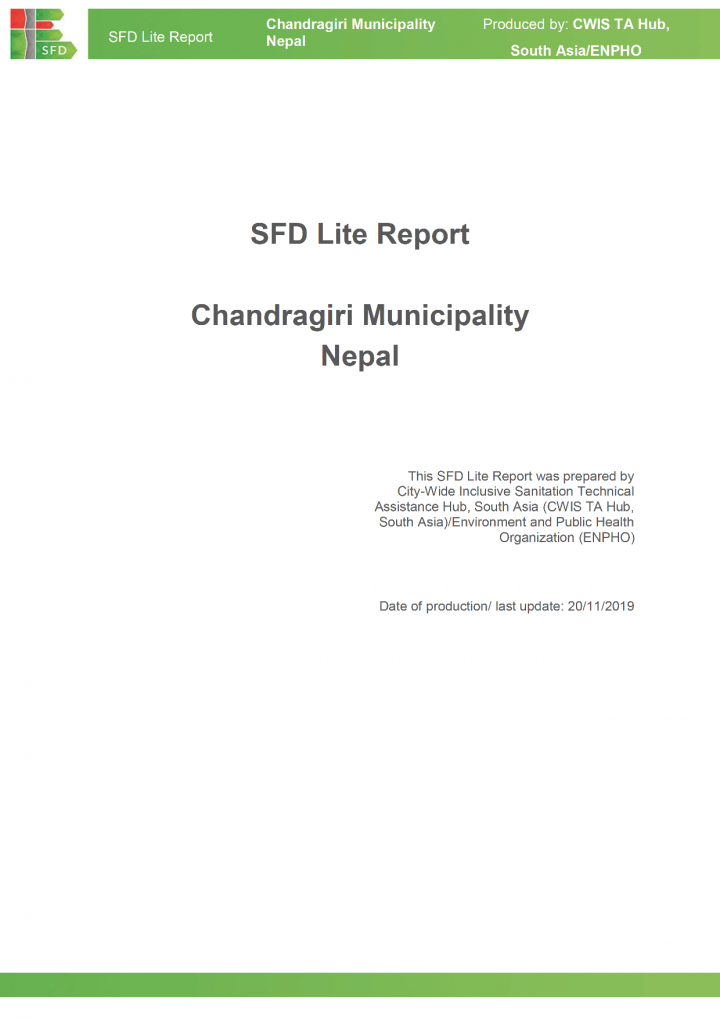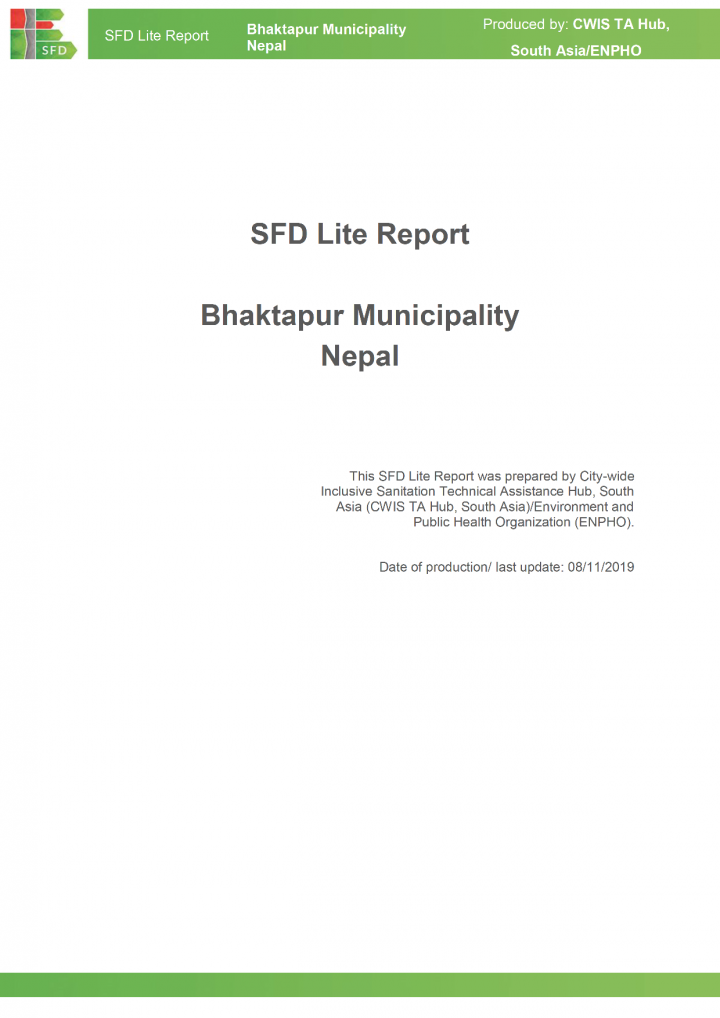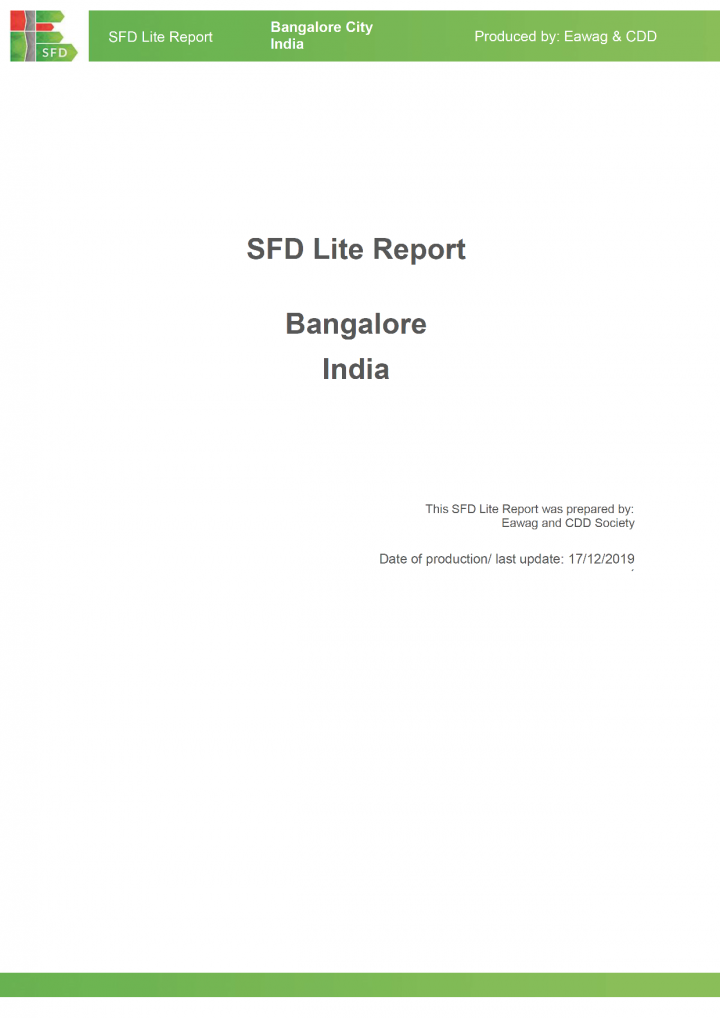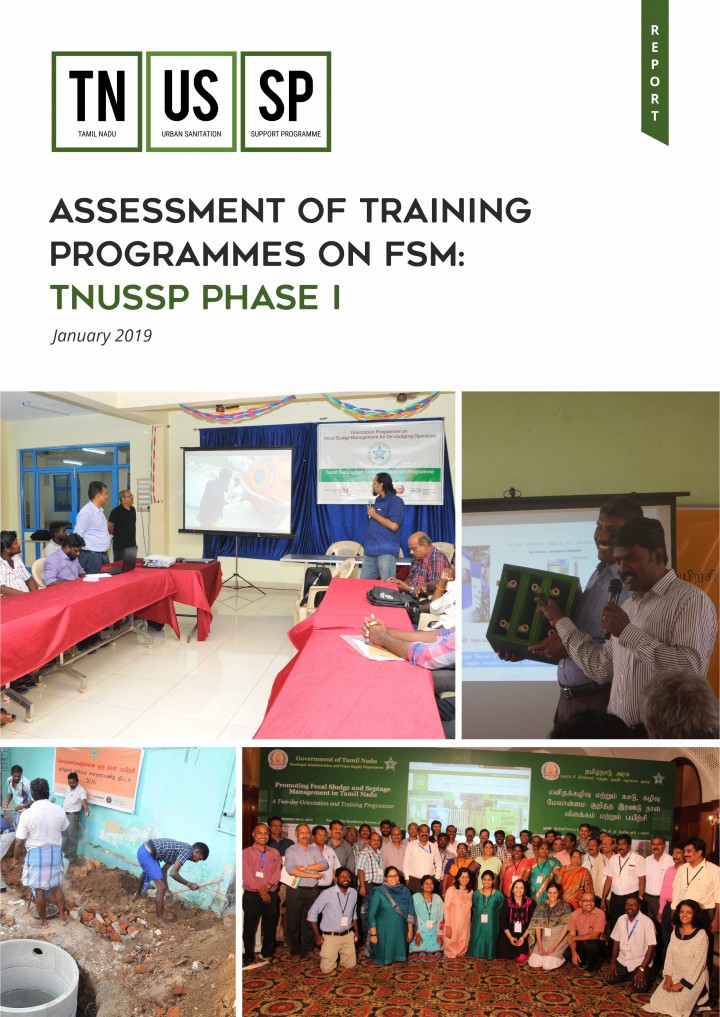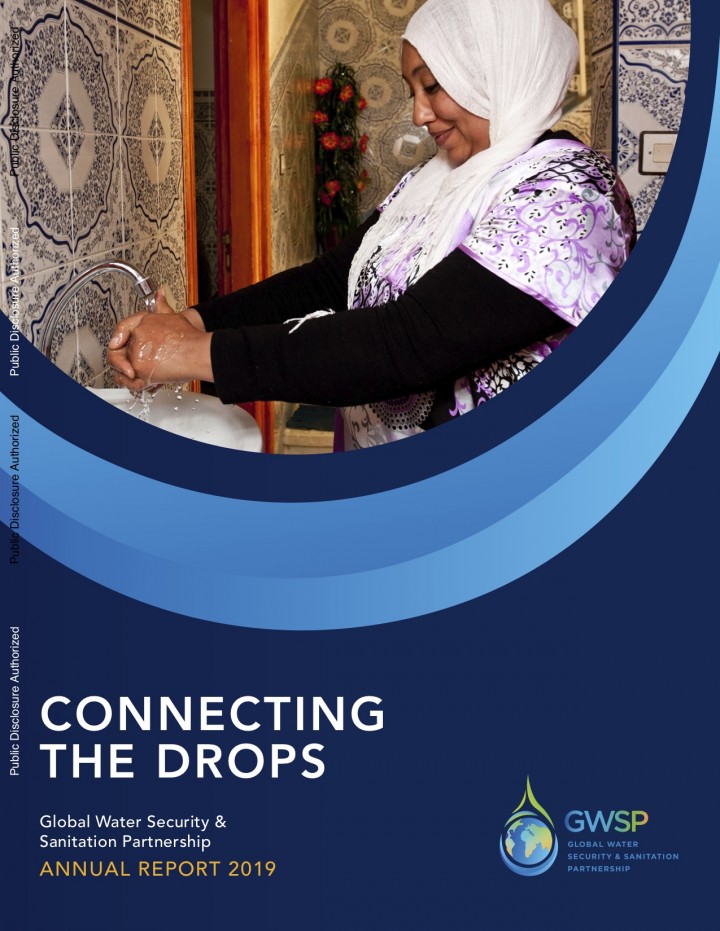Searching for information on Sanitation Workers?
The Sanitation Workers Knowledge + Learning Hub is the best source for all current news, trends, articles and updates on sanitation workers rights around the world.
For fecal sludge from households in low- and middle-income countries to be treated offsite it needs to be removed, which can be greatly affected by the pit latrine floor design. However, it is unclear whether precast pit latrine concrete floors (latrine slabs) can withstand emptiers and their equipment. To investigate this issue, 28 prefabricated latrine slabs were purchased in two cities of …
In sub‐Saharan Africa, informal markets account for more than 80% of the total food selling. Fish is a major protein source for households in Malawi and is commonly purchased from individual vendors. The aim of this study was to review national acts and policies and local regulations focused on fresh fish sold at open‐air markets or by mobile vendors and to further examine the water, …
Chennai, the capital of state of Tamil Nadu is located on a flat coastal plain known as the Eastern Coastal Plains. It is the fourth largest metropolitan city in India. The estimated present population of the city is 7.1 million. Overall, the SFD Graphic depicts that 62% of excreta is safely managed while 38% is discharged untreated to the environment. The wastewater system for the city has been …
The Global Handwashing Partnership Think Tank series brings together hygiene experts from civil society, government, research institutions, and the private sector to drive learning and action in handwashing behavior change. The 2018 Think Tank was hosted in Manila, Philippines, from October 10 – 12. The presentations can be found in the annex of the report.
Shankharapur Municipality is located in Kathmandu District in Province No. 3 of Nepal. It consists of 13 wards with the total population of 27,202 people residing in 5,607 households. The main sources of drinking water in Shankharapur Municipality are public taps, household bores and wells. Majority of the population are dependent on the public water supply (75%) and remaining 25% of the …
Mahalaxmi Municipality is one of the historic municipalities of Lalitpur district located in province no.3 of Nepal. The municipality consists of 10 wards with the total population of 112,157 people residing in 70,256 households. The main sources of drinking water in Mahalaxmi Municipality are public taps, household bores and wells. 23% of the population are dependent on sewer system. The most …
Kathmandu Metropolitan city is the eldest metropolitan city and capital of the Federal Democratic Republic of Nepal, located in Kathmandu district of Province no.3 of Nepal. The city consists of 32 wards with the total population of 1,347,011 people residing in 298,752 households. Majority of the population of Kathmandu Metropolitan city are dependent on sewer system, followed by lined tanks with …
Gokarneshwor Municipality is located in Kathmandu District in Province No. 3 of Nepal. The municipality consists of 9 wards with the total population of 107,351 people residing in 27,106 households. Majority of the population are dependent on public taps as the main source of drinking water. The remaining population are dependent on spring water, tap water (bore water) and wells. Most of the …
Rajgir is an ancient town within the district of Nalanda in the state of Bihar. According to Census (2011), Rajgir has a total population of 41,587 living in 7,030 households. 20% of the excreta is managed safely and 80% is unsafely managed. Approximately, 10% of the population is covered under a centralized underground sewerage network. Despite the presence of a sewer network, 60% of the …
Godawari Municipality is located in Lalitpur District in Province No. 3 of Nepal. The municipality consist of 14 wards with the total population of 116,045 residing in 18,232 households. The majority of the population use lined tanks with impermeable walls and open bottom followed by fully lined tanks, lined pits with semi-permeable walls and open bottom, pits (all types) never emptied but …
Dakshinkali Municipality is located in Kathmandu District in Province No. 3 of Nepal. The total population is 24,297 people residing in 6,925 households. Majority of the population (80%) are dependent on public taps and the remaining 20% of population are dependent on spring water. 14% of the population depend on an offsite sanitation system but most of the population in Dakshinkali Municipality …
This report presents results of the project 'Circular economy in sanitation for agriculture – Faecal sludge management with cocomposting for vegetables cultivation in the Nilgiris', which started in 2017 and is funded under the Securing Water for Food programme and the FINISH Mondial programme.
This report details the monitoring and evaluation of the recent innovation by WASTE among the small-scale farmers of the horticulture district of Nilgiris in the state of Karnataka in July 2019. Fifty independent farmers were selected for interviews through a random sampling with a mix of male and female headed households. Criteria was established to assess household income, crop yield, water …
Chandragiri Municipality is located in Kathmandu District in Province No. 3 of Nepal with a total population of 85,198 residing in 20,532 households. The main sources of drinking water in Chandragiri Municipality are public taps, household bores and wells. Majority of the households are dependent on public water supply. The majority of the population use lined tanks with impermeable walls and …
Budhanilkantha Municipality is located in Kathmandu District in Province No. 3 of Nepal with a total population of 153,303 people residing in 32,039 households. Most of the population are dependent on the sewer system followed by fully lined tanks, lined tanks with impermeable walls and open bottom, septic tanks, user interface directly connected to open drain and lined pits with semi-permeable …
Bhaktapur Municipality is located in Bhaktapur district of Province no.3 of Nepal. The total number of people is 81,748, living in 17,639 households. Majority of the population of Bhaktapur Municipality are dependent on public water supply and their own source such as well and tap water. Mostly, the population of Bhaktapur Municipality
are dependent on sewer system followed by fully lined tanks, …
Bangalore, the capital city of Karnataka is the third largest city and the fifth largest metropolitan area in India and is fast growing. It is a centre for education, IT and biotechnology, advanced health care and is home to many more Multi National Corporations (MNCs) which attract people to the city. As per Census 2011, the population of Bangalore City was about 8.5 million. Overall, the SFD …
This guide describes commonly available MHM materials, its advantages and disadvantages to enable practitioners to choose what materials might be adequate for their target population and their context.
For each menstrual material, the environmental, health, and financial aspects are highlighted in individual tables – along with considerations of availability, user experience, and standards …
This Programming Guidance outlines essential parts of MHH programming, characteristics of good programming and examples of good practice.
It features 5 main sections:
- A global opportunity: explaining the global interest in supporting MHH
- Programm design: principles, government leadership, situation analysis, theory of change, costs
- Core package of interventions: framework of essential …
Capacity building initiatives and programmes were conducted for a range of stakeholders – Government officers, engineers, masons and desludging operators. An assessment was undertaken to see the impact of these programmes on the stakeholders and if they have been able to apply new learnings in their work environment. This report presents the findings of the assessment.
The Global Water Security & Sanitation Partnership (GWSP) is an international partnership launched in 2017 to support countries around the world in meeting the targets related to water in the Sustainable Development Goals (SDGs), particularly those of Goal 6, which calls on the global community to “ensure availability and sustainable management of water and sanitation for all.” Administered …
The crucial role women play in managing and safeguarding water at the domestic and community level has long been recognized. Across the world, women and girls bear the brunt of collecting water—often from long distances or in harsh conditions—and usually bear responsibility for household hygiene and sanitation needs. What has been less explored is the intersection between water, gender, and …
Achievement of adequate and equitable access to sanitation for all, and an end to open defecation, requires that special attention is given toward disadvantaged groups. It has become apparent that the benefits of conventional rural sanitation programming and service delivery are often not spread equally, and risk leaving disadvantaged groups behind. This issue of Frontiers of CLTS examines the …
In this library entry we have grouped together up to five documents that we think are important "first reading" materials for anyone wishing to obtain a quick overview of this topic. For more details, please see the external links to the discussion forum below.
The documents listed in this library entry in reverse chronological order already exist as individual library entries but have been …

